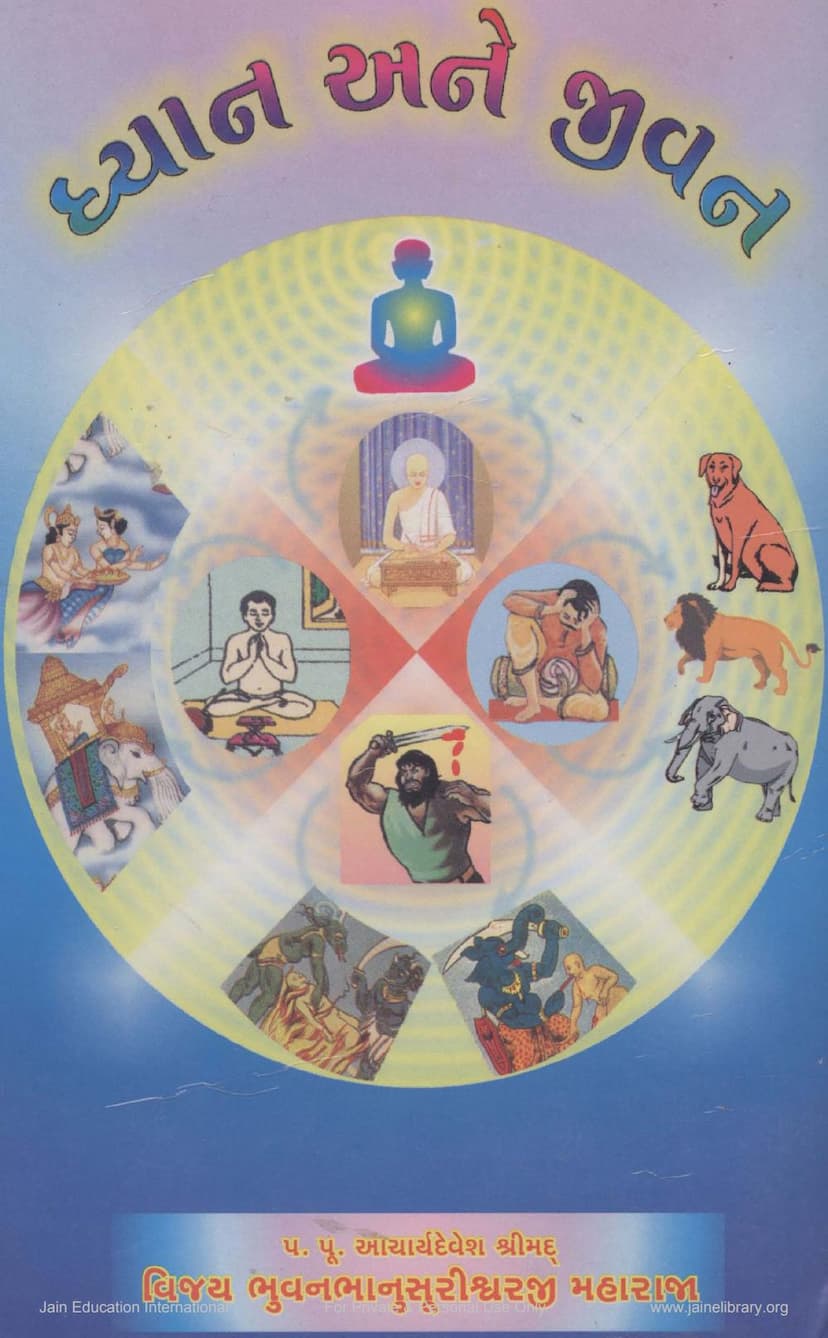Dhyan Ane Jivan
Added to library: September 1, 2025

Summary
Here is a comprehensive summary of the Jain text "Dhyan ane Jivan" (Meditation and Life) in English, based on the provided pages:
Book Title: Dhyan ane Jivan (Meditation and Life) Author(s): Bhuvanbhanusuri, Padmasenvijay Publisher: Omkar Gyanmandir Surat Catalog Link: https://jainqq.org/explore/004948/1
Overall Summary:
"Dhyan ane Jivan" is a profound Jain text compiled from the discourses of Acharya Shrimad Vijay Bhuvanbhanusurishwarji Maharaj, edited by P.P. Punyas Shri Padmasenvijayji Ganivar. Published by Acharya Shri Omkarsuri Gyanmandir, Surat, this book delves into the multifaceted concept of meditation (Dhyan) and its integral connection with daily life (Jivan) from a Jain philosophical and practical perspective. The book emphasizes that meditation is not merely a ritualistic practice but an essential element that permeates all auspicious activities, guiding one towards spiritual upliftment and liberation.
The text draws heavily from ancient Jain scriptures, particularly highlighting the "Dhyan-Adhyayan" or "Dhyan-Shatak," a treatise of 105 verses composed by the venerable Jinbhadra Gani Kshamashraman. The core message of the book is that while external circumstances may be adverse, true happiness and peace stem from the state of the mind and its ability to remain focused through meditation. It aims to provide practical guidance and scriptural insights to help readers understand the true nature of meditation, differentiate between auspicious and inauspicious thoughts, and navigate the complexities of spiritual practice in everyday life.
Key Themes and Concepts:
-
The Nature of Meditation (Dhyan): The book clarifies that meditation is not limited to a specific posture but is an integral part of all auspicious actions. It is the focused concentration of the mind on a particular subject, whether external or internal, auspicious or inauspicious.
-
Karma and Suffering: A significant portion of the text explains that life's difficulties and suffering are not random but are the result of past negative karma (ashubh karma). Understanding this concept, particularly the process of karma disposal (karma-nikal), is crucial for maintaining equanimity. The book teaches that experiencing suffering is also a way of exhausting past negative karma.
-
The Mind's Role in Life: The mind is presented as the creator of happiness and sorrow, success and failure, and ultimately, the architect of one's destiny, leading towards either eternal worldly existence or liberation (Moksha). The importance of controlling and directing the mind through proper focus (Dhyan) is repeatedly stressed.
-
Differentiating Auspicious and Inauspicious Meditation: The text elaborates on the types of meditation:
- Artadhyan (Mournful Meditation): Arising from attachment to pleasant (isht) experiences and aversion to unpleasant (anisht) situations, leading to grief and worry. It is further categorized into four types related to situations of loss, suffering, seeking pleasantness, and vain desires.
- Raudra Dhyan (Fierce Meditation): Characterized by intense anger, cruelty, violence, deceit, and greed. It is described as fierce and detrimental, leading to negative karmic consequences.
- Dharmadhyan (Righteous Meditation): Stemming from righteous thoughts, virtue, and the understanding of spiritual truths. It leads to positive karma and spiritual progress.
- Shukladhyan (Pure Meditation): The highest form of meditation, leading to spiritual purification and ultimately liberation, characterized by extreme detachment and mental clarity.
-
The Namaskar Mantra (Navkar Mantra): The book highlights the profound significance of the Namaskar Mantra, emphasizing its power to bestow both worldly and spiritual benefits, and its role as a Mahamantra for overcoming obstacles and achieving liberation. The proper method and benefits of meditating on the Navkar Mantra are explained with illustrative examples.
-
The Importance of Balanced Living and Subtlety: The text advocates for balanced living, where one's actions, speech, and thoughts are aligned. It criticizes superficial spiritual practices and emphasizes the need for genuine internal transformation. The concept of "Dhyan" is presented as a continuous state of mind, not just a momentary practice.
-
The Role of Virtuous Intentions (Bhavana) and Actions: The book underscores that virtuous intentions (shubh bhavna) and actions are paramount. It explains how even mundane activities can be transformed into spiritual practices when performed with the right mindset and focus.
-
Practical Guidance for Meditation: Various techniques and approaches to meditation are discussed, including focusing on letters of mantras, contemplating deities (Chovvīs Tirthankar), visualizing sacred diagrams (Samavasaran), and maintaining mental stillness.
-
Overcoming Obstacles: The text addresses common challenges faced during meditation, such as distracting thoughts, mental wandering, and the influence of desires and attachments. It provides strategies for overcoming these obstacles and maintaining focus.
-
The Interplay of Dhyan and Jivan: A central theme is the inseparable link between meditation and life. Meditation is not an escape from life but a way to navigate it with wisdom, equanimity, and purpose. It teaches how to cultivate positive mental states and integrate spiritual principles into daily activities.
-
The Power of Positive Thinking and Intention: The book emphasizes the impact of thoughts and intentions on one's reality and karmic outcome. Cultivating auspicious thoughts and intentions is presented as a direct path to spiritual progress and well-being.
-
The Significance of Virtues and Practices: The text highlights the importance of virtues like non-violence (ahimsa), truthfulness, non-stealing, celibacy, non-possession, forgiveness, patience, and contentment as essential components of a meditative life.
-
The Role of Spiritual Teachers (Gurus): The guidance of an enlightened Guru is presented as vital for understanding and practicing meditation effectively, especially in navigating the subtle aspects of the mind and overcoming obstacles.
In essence, "Dhyan ane Jivan" serves as a comprehensive guide for spiritual seekers, offering practical advice and philosophical depth on integrating meditation into the fabric of life for personal and spiritual transformation, ultimately leading towards the ultimate goal of liberation. The book aims to empower individuals to control their minds, cultivate inner peace, and lead a life of purpose and spiritual awareness.